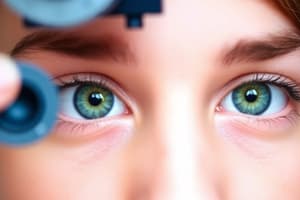Podcast
Questions and Answers
What is the primary function of a keratometer?
What is the primary function of a keratometer?
- To examine the retina
- To measure the curvature of the cornea's anterior surface (correct)
- To detect cataracts
- To assess the optic nerve
Who developed the first keratometer in the late 18th century?
Who developed the first keratometer in the late 18th century?
- Hermann von Helmholtz
- Johann Gauss
- Sir James Ramsden (correct)
- Albrecht von Graefe
Which ophthalmologist developed a device incorporating light-emitting diodes (LEDs) for producing corneal light reflections?
Which ophthalmologist developed a device incorporating light-emitting diodes (LEDs) for producing corneal light reflections?
- Placido (correct)
- Landolt
- Schiötz
- Javal
What is the primary role of keratometers in assessing refractive errors?
What is the primary role of keratometers in assessing refractive errors?
How do modern keratometers differ from early devices in terms of measurement range?
How do modern keratometers differ from early devices in terms of measurement range?
Which ophthalmologist is NOT associated with significant contributions to the development of keratometers?
Which ophthalmologist is NOT associated with significant contributions to the development of keratometers?
What distinguishes keratometers from corneal topography systems?
What distinguishes keratometers from corneal topography systems?
How have modern developments improved keratometers?
How have modern developments improved keratometers?
In what way do infant keratometers differ from open-field infant keratometers?
In what way do infant keratometers differ from open-field infant keratometers?
What impact does artificial intelligence (AI) have on keratometers?
What impact does artificial intelligence (AI) have on keratometers?
How do advanced keratometers differ from traditional ones?
How do advanced keratometers differ from traditional ones?
What information can be derived from quantitative assessments offered by open-field infant keratometers?
What information can be derived from quantitative assessments offered by open-field infant keratometers?
Study Notes
Keratometers: Past, Present, and Future
A keratometer is an important diagnostic tool in the field of ophthalmology, specifically designed to measure the curvature of the cornea's anterior surface. By providing information on the spherical and astigmatic components of the corneal curvature, keratometers play a crucial role in assessing refractive errors and guiding various surgical procedures. Here we delve into the history and evolution of keratometers, their usage in vision science, and recent advancements in the technology.
Origins and Evolution
The origins of the keratometer can be traced back to the late 18th century when Sir James Ramsden developed the first keratometer. Later, instruments were improved upon by notable figures such as Javal and Schiötz, Gauss, Purkinje, Placido, Schiotz, Landolt, and von Helmholtz. These pioneering ophthalmologists contributed significantly to the advancements in the field through their research and development of novel measuring devices.
Early keratometers varied greatly in design, ranging from small fixed objects like Helmholz's variable doubling device to larger devices such as Placido's disc, which incorporated light-emitting diodes (LEDs) as light sources to produce corneal light reflections. Modern keratometers typically measure the corneal curvature within the central 4mm of the cornea using LEDs and digital imaging technology.
Infant Keratometers
The introduction of automated keratometers in the early 1980s revolutionised the diagnostic landscape, providing ease of use and reliability for practitioners. Subsequent advances in infant keratometers led to the development of open-field infant keratometers, which employ a range of calibration fixtures and lens systems to precisely position the measurement object for accurate measurements. These advancements allowed for quantitative assessment of infants' corneal shapes, providing valuable insights into refractive errors and guiding early intervention strategies.
Comparison with Other Vision Technologies
Keratometers differ significantly from corneal topography systems, which measure higher-order aberrations and provide detailed surface maps of the entire cornea. While keratometers focus on measuring the curvature of the anterior corneal surface, corneal topography systems offer a comprehensive analysis of the corneal shape, including its higher-order aberrations.
Modern Developments and Future Perspectives
Recent advancements in optical technologies have led to the development of advanced keratometers that employ laser technology or high-resolution imaging sensors to capture minute details of the corneal surface. These sophisticated instruments allow for more precise measurements and improved diagnostic accuracy, further enhancing the clinical utility of keratometry.
Moreover, the integration of artificial intelligence (AI) and machine learning algorithms in the field of ophthalmology offers exciting prospects for future developments in keratometers. AI can assist in analyzing keratoscopic images, potentially leading to automated reporting systems that minimise variability and improve overall diagnostic efficiency.
In conclusion, keratometers have come a long way since their inception, evolving from rudimentary devices to highly advanced instruments capable of precise and reliable measurements. With ongoing advancements in optical technologies and the integration of AI, keratometers continue to play a pivotal role in the detection and management of refractive errors, contributing to better vision outcomes for patients.
Studying That Suits You
Use AI to generate personalized quizzes and flashcards to suit your learning preferences.
Description
Explore the historical development, modern applications, and future innovations of keratometers, essential tools used for measuring corneal curvature in ophthalmology. From the first keratometer by Sir James Ramsden to the latest AI-integrated devices, learn about their impact on diagnosing refractive errors and guiding surgical procedures.




